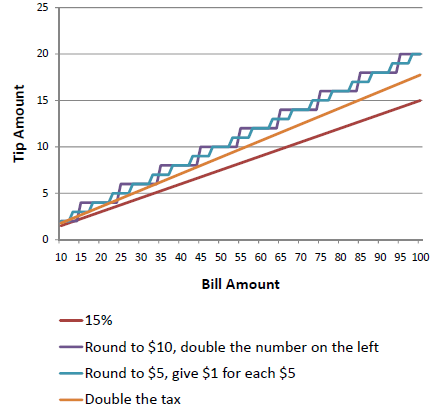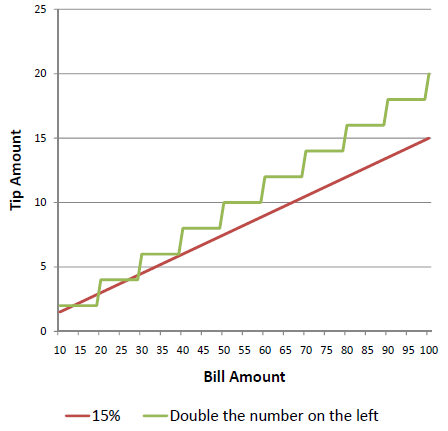Tipping heuristics
INCREDIBLY SIMPLE CALCULATIONS MADE SIMPLE
Yes, we all know how to calculate 15% or 20% exactly, but it’s fun to use tipping heuristics and even more fun to make crowded graphs of how they compare to each other. (Sorry for the junky chart. Open for suggestions, in the words of Tom Waits.)
Here are a few tipping heuristics compared to a 15% baseline (which some claim to be 15-20% in NYC):
– Round to the nearest $10, then double the number on the left
– Round to the nearest $5 and throw in $1 for every $5
– Double the tax
There is also the notorious “double the number on the left”, which a friend’s father described as “sometimes they win, sometimes they lose.” DSN doesn’t like this one as it inflicts its damage on small checks, which often require as much waitstaff effort as large ones. If you’re a high roller, it looks pretty safe, however.
Whatever you do, please advocate smart heuristics instead of those undeservedly popular iPhone tipping apps.
What tipping rule of thumb do you use?
Note: Tax figure is New York City restaurant tax, which is something like 8.875%. I regret doing this in Excel instead of R, but it seemed like it would be faster and prettier.




Some interesting heuristics there. Never heard of the “double the number on the left” rule. What I do is mentally take 10% by simply shifting the decimal place over, then double that new number and round to the nearest $1 (or $.50 for very small checks). A check of $27.50 means a tip of 2.75 x 2 = 5.50 = $5 or $6. I rarely intend to tip less than %20 so this works well for me.
April 29, 2010 @ 10:09 am
Thanks, Jake! Can you define “small” in in this context?
April 29, 2010 @ 1:25 pm
I can try. I suppose that a very small check in the context of using this rule would be when rounding the tip off to the nearest dollar would result in a substantial (or at least noticeable) percentage change in the tip. For example, if I go out for a single beer with a friend after work and my check comes out to $3.00, this rule says that I should tip .30 x 2 = .60, but rounding to 1 makes it 33% rather than 20%. Not a big deal at the end of the day, I know…
April 30, 2010 @ 2:13 am
On a side note, I just figured out what “doubling the number on the left” even means. (I had been wondering, to the left of what?) I guess that’s not really that different from what I do, really…
April 30, 2010 @ 2:17 am
I do agree with Jake as i so also Never heard of the “double the number on the left” rule.
This will help, Thanks for sharing this online.
May 3, 2010 @ 8:48 am